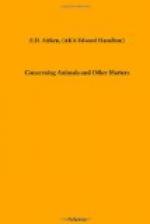Foedaque fit volucris venturi nuncia luctus,
Ignavus bubo, dirum mortalibus omen.
In India, to-day, if an owl sits on the house-top, the occupants dare scarcely lie down to sleep, for they know that the devil is walking the rooms and marking someone for death. Lady Macbeth, when about the murder of Duncan, starts and whispers,
Hark! Peace! It was the owl
that shrieked,
The fatal bellman.
And even as late as the nineteenth century, Waterton’s aged housekeeper “knew full well what sorrow it had brought into other houses when she was a young woman,” Witches, like modern ladies of fashion, set great value on its wings. The latter stick them on their hats, the witches in Macbeth threw them into their boiling cauldron. Horace’s Canidia could not complete her recipe without
“Plumamque nocturnae strigis.”
We may suppose that in Britain these superstitions are gone for ever, killed and buried by board schools and compulsory education. If they are (there is room for an if) they have been succeeded by a worse, the superstition of gamekeepers and farmers. It is worse in effect, because these men have guns, which their predecessors had not. And it is more wicked, because it is founded on an ignorance for which there is no excuse. How little harm the barn owl is likely to do game may be inferred from the fact that, when it makes its lodging in a dovecot, the pigeons suffer no concern! Waterton (and no better authority could be quoted) scouts the idea, common among farmers, that its business there is to eat the pigeons’ eggs. “They lay the saddle,” he says, “on the wrong horse. They ought to put it on the rat.” His predecessor in the estate had allowed the owls to be destroyed and the rats to multiply, and there were few young pigeons in the dovecot. Waterton took strong measures to exterminate the rats, but built breeding places for the owls, and the dovecot, which they constantly frequented, became prolific again.
But granting that the owls did twice the injury to game with which they are credited, it would be repaid many times over by their services. Waterton well says that, if we knew its utility in thinning the country of mice, it would be with us what the ibis was with the Egyptians—a sacred bird. He examined the pellets ejected by a pair of owls that occupied a ruined gateway on the estate. Every pellet contained skeletons of from four to seven mice. Owls, it may be necessary to explain, swallow their food without separating flesh from bone, skin and hair, and afterwards disgorge the indigestible portions rolled up into little balls. In sixteen months the pair of owls above-mentioned had accumulated a deposit of more than a bushel of these pellets, each a funeral urn of from four to seven mice! In the old Portuguese fort of Bassein in Western India I noticed that the earth at the foot of a ruined tower was plentifully mixed with small skulls, jaws and other bones. Taking home a handful and examining them, I found that they were the remains of rats, mice and muskrats.




